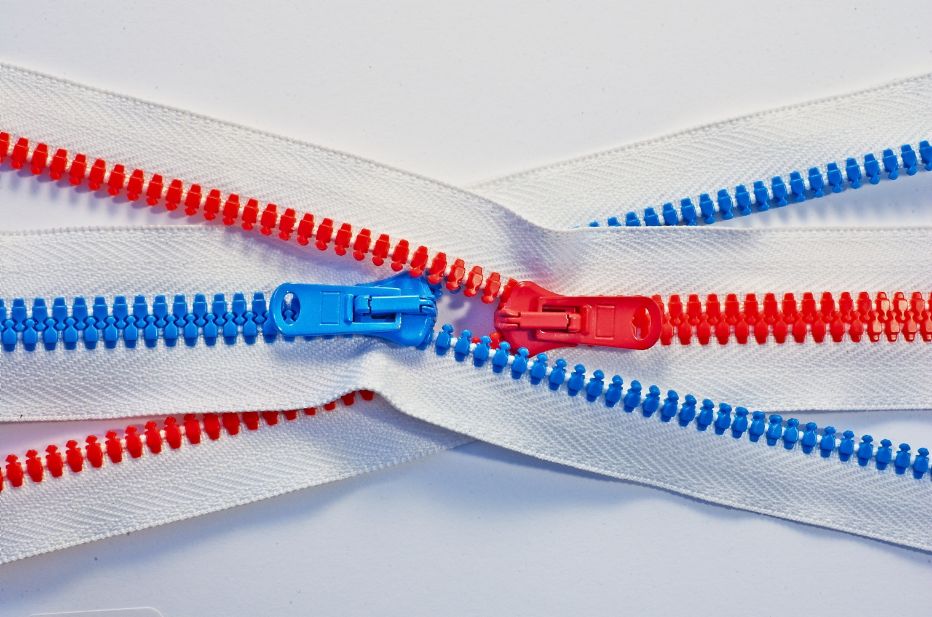
In the real world, zippers are frequently used to close bags and clothing. The mechanics of this tool are also straightforward. However, do you know how zippers operate?
A zipper track is made up of dozens of teeth, each of which combines a hook and a hollow. Every hook on each of the two tracks is intended to latch into a hollow on the other track. The latching mechanism, called the slide, is just a collection of wedges. Please read on for more information.
What Is The Zipper?
Your life is made incredibly convenient by the wonderful modern invention known as the zip. This fastener connects the edges of an opening (like the mouth of a garment or bag) with a row of metal or plastic teeth on two straps, and a slider pulls the two rows of teeth into an interlocking position to close the opening.
A zipper is a chain that is attached to something to tighten, stabilize, or guide it—for instance, an object that will be lifted or dropped.
History Of The Zipper
The first closure that might have served as a model for the zipper was granted a patent in 1851. “Automatic, Continuous Closure” was how it was described.” The creator, Elias Howe, decided against putting it on the market. Howe’s invention, the “Clasp Locker,” was marketed by Whitcomb Judson in 1895.
Gideon Sundback was granted a patent in 1917 for the “Separable Fastener,” but it never gained popularity.” The B referred to this tool as a “zipper.”
The F adopted Sundback’s invention as a closure for their brand-new rubber boots. It was also used to seal tobacco-filled pouches, according to Goodrich Company. It wasn’t until 1937 that the zipper really began to catch on in the fashion industry.
Types Of Zippers
Zippers come in a wide variety of shapes and sizes. A zipper that is thicker, more durable, and less fragile will be less likely to break. Although there are many materials available for zippers, molded plastic, metal, and nylon coil are the most popular choices.
Depending on what it is attached to, the type of zipper you use will vary. In contrast to a jacket, stopping is not necessary when carrying a backpack. Typical types of zippers include:
- Closed-end zippers
- Separating zippers
- Two-way separating zippers
- Invisible zippers
The Parts Of A Zipper

To understand how zippers work, you should be familiar with their parts. Although they are not all the same, zippers frequently have some things in common. A zipper has the following components:
- The track consists of teeth or coils that interlock
- The slider body separates and joins the teeth together
- The pull tab that allows you to use the slider
- The top and bottom stop prevents the zipper from coming apart at each end
- The tape, which is the fabric to which the teeth are attached
How Do Zippers Work?
In order for two rows of angled teeth to mesh together, a zipper uses a slider with a wedge shape. This creates a very solid seal that is difficult to break until the wedge slider descends again and angles the teeth back apart.
You can better understand how zippers function by knowing that they have several essential components.
- The fabric or plastic strip that is located outside of the teeth on both sides is known as the tape. This gives a way to sew the zipper onto the item or garment. For added security, the teeth on most contemporary zippers are directly molded onto this tape.
- The teeth have a distinctive shape with a hooked top and a hollow lower portion also referred to as a concave-convex structure. Each tooth will snick into the hollow of the teeth on the opposite side of the tape when they are engaged together. A tight seal is made possible by this ideal fit, where all of the hooks and hollows line up.
- There are various types of teeth. The teeth on the tape are sometimes molded from plastic, but they can also be made from coiled nylon and sewn to the tape. Metal teeth are frequently stitched onto the tape for metal zippers.
- Each row of teeth will have a stop, which is a tiny metal or plastic rectangle, at the top and bottom. This lessens the likelihood that the slider will slide straight off the teeth.
- Latching is accomplished by the slide. The interior of a slide resembles a Y, with a wide section that tapers to a narrow one. The teeth are forced together as a result of the slide moving easily over them. The slide’s downward-pointing section creates an external-facing wedge that is precisely angled to cut through the teeth and pull the hooks apart to unzip.
- To make it simple for you to raise and lower the slide through the teeth, a pull is attached to the top of the slide.
Is It Possible To Repair A Splitting Zipper?
You can often fix a zipper that keeps separating with a few simple techniques and a couple of tools. However, how a problem is framed will affect this.
You probably need to replace the zipper if you check it and find that it has separated because the teeth or coil pulled free from the tape. This holds true for missing teeth as well. Since teeth must perfectly match one another in order to stick together in that woven chain, replacing teeth is difficult.
In many cases, you can disassemble the zipper and rebuild it to realign the teeth if you try to zip up and they simply aren’t aligned properly. The following section will teach you a few different techniques for performing this repair.
You can use a few common household items to tighten the slider and get it back to the proper angle for wedging through the teeth if this is another frequent issue. The slider may have become too loose.
The zipper pull is very simple to replace if you lose it. The zip should only be replaced if you lose the slider or a few teeth.
Ways To Fix A Stuck Zipper
There are a lot of different methods you can use to unstick a zipper, including the following ones:
- Use a graphite pencil. If a zipper is stuck, start by using a graphite pencil. Run the pencil’s tip along the zipper’s teeth as it is closed to try and bring it down.
- Use bar soap or wax. Consider using a lubricant like a bar of soap, some chapstick, or lip balm to help the teeth pass through more easily.
- Use petroleum jelly. If all else fails, use petroleum jelly. Apply a small amount of petroleum jelly with the tip of your finger to the zipper teeth to make it easier to unstick the stuck zipper. If the zipper is fastened to a piece of fabric, the jelly could leave a greasy stain if it is not properly removed.
